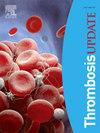Thrombin generation remains stable in frozen plasma over long-term storage
Q4 Medicine
引用次数: 0
Abstract
Background
The ST Genesia is a fully automated thrombin generation (TG) device. Measuring TG can be useful for medical purposes as it is an indicator for the bleeding or thrombotic risk of a patient. When measuring TG, it is of utmost importance to be careful with the preanalytical part as it can affect TG. One of the preanalytical steps to be cautious with, is the plasma sample storage temperature and duration.
Methods
Citrated blood was collected and centrifuged twice for 10 min at 2840g to obtain platelet poor plasma. Plasma samples were stored directly in the freezer either at −20 °C or at −80 °C. TG was measured with a low, intermediate and high tissue factor concentration (STG-BleedScreen, STG-ThromboScreen and STG-DrugScreen, respectively) in fresh samples and after storage at -20°C and -80°C for 1 day, 1 month, 3 months, 6 months and 12 months. The samples stored at −80 °C were also measured after 18 and 24 months.
Results
Freezing platelet poor plasma samples did affect the TG parameters. This observation was independent of the storage temperature and the tissue factor used for triggering TG. Interestingly, TG was not significantly affected by time in storage at −20 °C and −80 °C even up to one year or two years, respectively. Some variation was observed in the samples measured with thrombomodulin, which may have been due to the use of a reagent kit with different lot number.
Conclusion
Freezing plasma does affect TG independently of the storage temperature. However, once frozen, the TG does not vary significantly in time even up to one or two years for samples stored at −20 °C and −80 °C, respectively.

凝血酶的生成在冷冻血浆中长期保存是稳定的
ST Genesia是一种全自动凝血酶生成(TG)设备。测量TG可用于医疗目的,因为它是一个指标出血或血栓形成的风险的病人。当测量TG时,最重要的是要小心分析前部分,因为它会影响TG。分析前需要注意的一个步骤是血浆样品的储存温度和持续时间。方法采集静血,2840g离心2次,10 min,获得血小板差血浆。血浆样品直接保存在- 20°C或- 80°C的冷冻室中。在新鲜样品和在-20°C和-80°C保存1天、1个月、3个月、6个月和12个月后,分别采用低、中、高组织因子浓度(分别为stg - bleeding screen、STG-ThromboScreen和STG-DrugScreen)测量TG。在- 80°C保存的样品也在18个月和24个月后进行测量。结果冻结血小板含量低的血浆样品对TG参数有影响。这一观察结果与储存温度和触发TG的组织因子无关。有趣的是,TG分别在- 20°C和- 80°C下保存一年和两年,并没有受到时间的显著影响。在用血栓调节素测量的样品中观察到一些变化,这可能是由于使用了不同批号的试剂盒。结论血浆冷冻对TG的影响与贮藏温度无关。然而,一旦冻结,即使在- 20°C和- 80°C分别储存的样品长达一年或两年,TG也不会随时间发生显着变化。
本文章由计算机程序翻译,如有差异,请以英文原文为准。
求助全文
约1分钟内获得全文
求助全文

 求助内容:
求助内容: 应助结果提醒方式:
应助结果提醒方式:


